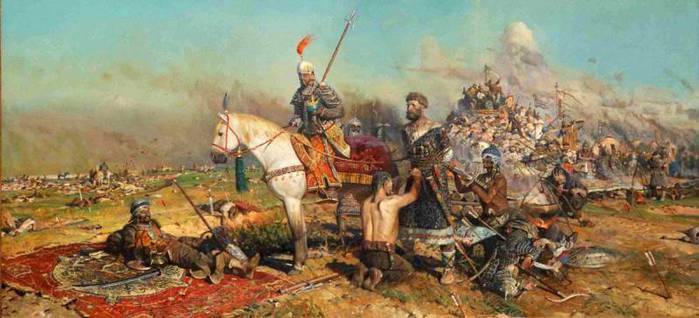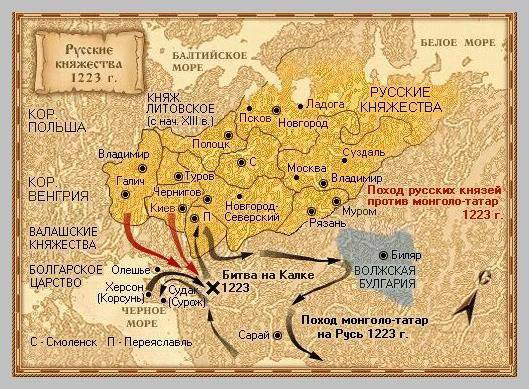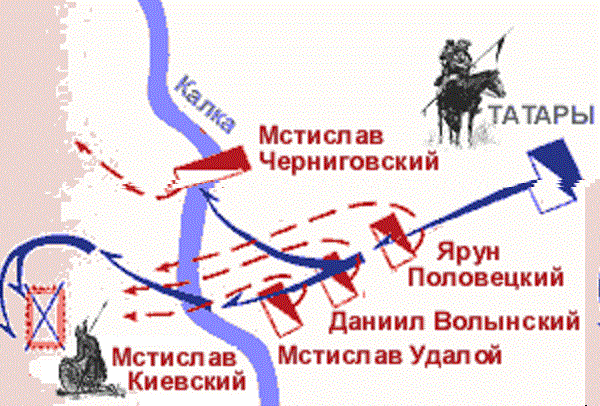Military tragedy on the river Kalka

31 May 1223, a battle took place between the Russian-Polovtsian regiments and the Tatars on the Kalka River. This was the first clash of Russian troops with the forces of the state of Genghis Khan. The hard battle ended with the most severe defeat of the Russian-Polovtsian troops.
prehistory
At the beginning of the 13 century, a new empire appeared in East Asia - its creator was a talented commander and wise manager Temujin (Genghis Khan). He subjugated a significant number of tribes and peoples, became the conqueror of northern and central China, defeated Khorezm. In 1220, Chingis Khan received information that Khorezmshah Mohammed was collecting forces on the banks of the Amu Darya. To defeat him, he repaired three tumens ("darkness" - 10-thousand cavalry corps) under the command of his best commanders - Jebe, Subedei and Tokhuchara. Subsequently, the Tohuchara Corps was recalled. The pursuit of Khorezmshah resulted in a long reconnaissance campaign. Having defeated Azerbaijan and Georgia, Tatar troops crossed the Derbent pass in 1222 and invaded the North Caucasus. Here they are faced with the combined forces of the Alans and Polovtsians. After the opponents failed to win in battle, military cunning was applied - the Polovtsy were promised peace and generously rewarded. Polovtsi left their allies. Tatars defeated Alan. And then in the decisive battle on the Don, the Polovtsi troops were defeated. In battles, the khans Yuri Konchakovich and Danila Kobyakovich died, and the remnants of their tribes fled to the west and joined up with a horde of Kotyan Sutoyevich, who wandered between the Dnieper and the Dniester.
At the beginning of 1223, the Tatars invaded the Crimea and ransacked it, and the city of Sudak (Surozh) was captured. Khan Kotyan addressed his son-in-law, Galician prince Mstislav Mstislavich Udalym (he was glorified as a successful commander) and other Russian princes, asking them for help against the new formidable enemy: "Today they have taken our land, tomorrow your will be taken." It should be noted that the Polovtsy were not only opponents of Russia in the south, but often allies in the struggle of various Russian princes among themselves, or used against external enemies. So, in the spring of 1221, Mstislav, with the help of the Polovtsy, beat off Galich from the Hungarians. Russian and Polovtsy tied trade, dynastic marriages. Therefore, Kotyan's request is not surprising.
In Kiev, a council of princes of southern Russian lands was assembled, headed by three grand dukes - Mstislav Romanovich (Kiev), Mstislav Mstislavich (Galich) and Mstislav Svyatoslavich (Chernigov). After long disputes and persuasions, Kotyan and Mstislav the Remote decided: "If we don’t help them ... then the Polovtsi will stick to the enemies, and their strength will be greater." The Princely Council decides to collect troops and meet the enemy on the borders of Russia.
Trekking
The collection of troops was assigned to Zarub, near the Varyazhsky Island (the island was located opposite the mouth of the River Trubezh). More than 20 princes with their retinue took part in the campaign. The strongest troops were the prince of Kiev and Chernigov with the henchmen of princes, and the Galician prince Mstislav (under his command was the Prince of Volyn, Daniel Romanovich). In total, the Russian-Polovtsian army consisted of approximately 40-45 thousand people (the number is also called in 80-100 thousand soldiers, but this is unlikely). These were mainly professional cavalry squads of princes and boyars, the most powerful Kiev army had foot militia.
The number of Tatar troops is also unknown. Two tumens, Subedei and Jebe, had 20-30 thousand horsemen, it was a battle-hardened core army. In addition, there were a number of different vagrants, robbers, adventurers, and prey-seekers who joined the army along its path (like roving).
Russian princes made a series of serious mistakes even before the battle itself. They will decide the outcome of the battle. The princes could not agree on a single command. In fact, there were three troops, decisions were made collectively. The first army (Kiev) was headed by the Grand Duke of Kiev Mstislav Romanovich, the formal head of the campaign. It includes the Kiev regiment, guards his son Vsevolod Mstislavsky and son Prince Andrei Ivanovich (Turovsky Prince) Prince Svyatoslav Ingvarevich Shumsky, Prince Nesvizh Yaropolkovicha George, Prince Alexander Dubrovytsky Glebovich, Ovruchsky Prince Vladimir Rurik and others. Princes. The second host (Chernigov-Smolensk) was led by Prince of Chernigov Mstislav Svyatoslavich. Slaves of Pereyaslavl Prince Mikhail Vsevolodovich, Kursk Prince Oleg Svyatoslavich, Princes Putivl Izyaslav Vladimirovich and Trubchevsky Svyatoslav Vsevolodovich obeyed him. The third army (Galician-Volyn-Polovtsy) was under the command of the initiator of the campaign of the Galician prince Mstislav the Remote (or Udatny). His troops included the forces of the Galitsky principality, the guards of the Volyn prince Daniil Romanovich, the Lutsk prince Mstislav Yaroslavich Nemy, the dorogobuzh prince Izyaslav Ingvarevich, the Polovtsian forces led by voivode Yarun.
Yuri Vsevolodovich, the Grand Duke of Vladimir-Suzdal Russia did not march, formally sent his nephew of Rostov Prince Vasily Konstantinovich to help the Russian army, but he did not have time to come to the beginning of the battle.
In Zaruba, Tatar ambassadors arrived at the Russian princes, they offered them an alliance against the Polovtsy. The princes considered that this was a trick and at the request of the Polovtsi they killed the envoys. Subedey and Jebe sent a new embassy, which declared war on Russia: “You listened to the Polovtsy and our ambassadors were interrupted; go against us, then go; we did not touch you, let God (the judge) be to everyone ”. This embassy was sent home. Mstislav Udaray insisted on active actions - to cross the Dnieper and hit the enemy in the steppe. Mstislav Romanovich Old offered to give battle to the enemy on the Dnieper and prepare for defense. Apparently, given the lack of unity in the army, this was the right strategy. Chernihiv prince Mstislav Svyatoslavich, adopted a wait-and-see attitude, not supporting either the proposal of the Galicians or the people of Kiev.
At this time, a Tatar reconnaissance detachment appeared along the banks of the Dnieper. Mstislav the Remote, he decided to attack - together with Daniel Romanovich he crossed the river and hit the enemy. The Tatars were defeated and fled. This victory dispelled all doubts - most of the princes and boyars came out for offensive actions. Mstislav Chernigovsky stopped hesitating and agreed to the crossing. As a result, another prerequisite for defeat appeared - the Russian command overestimated its strength and underestimated a virtually unknown enemy. The Tatars used their traditional battle tactics - luring the enemy under the blow of the main shock forces.
23 May Russian-Polovtsian troops crossed the Dnieper and moved to the Polovtsian steppes. Troops went eight days. They are very stretched. Polovtsy detachments and detachments under the command of Galician prince Mstislav the Remote went ahead, they were followed by the forces of Chernigov prince Mstislav Svyatoslavich, and the whole column was closed by detachments of the grand prince of Kiev Mstislav the Old. On the way, Rusich and Polovtsy were met by Tatar patrols, who at the first collision turned to flight, lured them. The army went joyfully, the enemy fled. They beat the abandoned cattle, they ate well. We regretted that they could not overtake the enemy and take away the huge booty that the Tatars seized in the plundered lands. A sense of superiority over the enemy captured all and relaxed the warriors. Another mistake was bad intelligence - the princes did not know about the readiness of the main forces of the enemy to fight.

Bits
31 May 1223 Russian-Polovtsian troops reached the Kalka River. In a fierce battle, advanced Russian forces drove the Tatar guard units to the other side. Mstislav Udaray did not wait for the approach of the main forces and, having crossed the river, hit the first line of the enemy troops (he did not know about the main forces of the enemy). He did not inform the Kiev and Chernigov prince about his plans, what made them angry (it seemed that the Galician prince wanted to appropriate all the glory to himself). The Kiev prince did not cross the river on the run and ordered the establishment of a fortified camp.
The most experienced Tatar commanders, Subedei and Jebe, immediately took advantage of this fatal mistake of the Russian princes: the enemy himself was under attack and allowed himself to be broken into pieces. The Polovtsi and regiments of Mstislav Udory faced a powerful army ready for a fierce battle. The Russian-Polovtsian forces pressed the enemy vanguard, but then collided with the main forces of the enemy. The Galician prince understood the depth of his mistake, but it was too late. The strike of the Russian-Polovtsian advanced forces was stopped, and then they were simply crushed. Polovtsy were the first to flee, their wave smashed the order, still beating Russian squads. The Chernigov army in general found itself in a situation where the advanced detachments had already entered the battle, and other units were only crossing the river. The Chernigov regiments were crushed and could not do anything, the flight became almost general. Separate resisting units could not change the outcome of the battle. In this massacre, the warrior Dobrynia Ryazanich Zlat Belt (one of the prototypes of the epic Dobrynia Nikitich) also resigned his head. Some units did not know and did not participate in the battle, lagging behind the main forces. They were picked up by the general stream of those running and pursuing.
The regiments of the Grand Duke of Kiev Mstislav Romanovich Old remained on the sidelines of this battle. A number of researchers believe that the timely entry into battle of his troops could change the outcome of the battle. But, apparently, the situation was already irreparable, the Polovtsy, the Galician and Chernihiv rati were defeated and fled. Part of the Tatar army pursued them. It was a massacre, not a battle. Only a small part managed to escape. A part of the Polovtsy left, with a handful of warriors, Mstislav the Remote and Daniil Romanovich were able to escape. The other part of the Tatar army overlaid the Kiev camp. The first assault attempts were repulsed. Mstislav Romanovich Kievsky and his troops three more days beat off the onslaught of the enemy. Tatars could not take fortifications, and did not want to destroy a large number of soldiers. Then they went to the trick: to Mstislav and his henchmen princes sent chieftain of the roamers (predecessors of the Cossacks) Ploskin, who promised life in exchange for surrender and mercy. There was nothing surprising in this - the Polovtsy more than once released the Russian princes for something. The princes believed and surrendered. It is necessary to take into account the fact that the troops ran out of water. After that, the princes were tied up and handed over to the Tatars, and the disarmed soldiers were attacked. There was another bloodbath. The Tatars themselves laid the princes under a wooden platform and made a “feast on the bones” on it.

The outcome and significance of the battle
- The main reason for the defeat was the lack of unity of the Russian army. If the Russian army acted in the traditional Russian style of battle: in the center the infantry (Kiev militia reinforced by other troops), on the wings of heavy princely horse guards (on the right Galician-Volyn, on the left Chernigov-Smolensk), leaving the Polovtsy in reserve, There were practically no Tatars. Fought in parts, unorganized, a significant part of the troops did not participate in the main battle at all. Administrative mistakes of command, underestimation of the enemy, led to the fact that the Tatars almost gave up the victory, allowing themselves to be broken into pieces.
- It was one of the hardest defeats of the Russian troops for all their history. South Russia was drained of the loss of thousands of the best warriors. According to the chronicle data, nine out of ten soldiers who went on a campaign were killed. Among them were 12 princes, including the princes of Kiev and Chernigov. Until the invasion of troops of Batu, the South Russian lands will not be able to restore their combat potential. Apparently, the Tatars also suffered substantial losses, since they could not carry out the invasion of Kiev lands and soon suffered a heavy defeat from the forces of Volga Bulgaria.
- The reconnaissance campaign of the Tatars revealed the main weak point of Russia - the lack of unity. It is not for nothing that Subedei will become the right hand and the actual commander in the Batu's Western campaign (1236 — 1242).
Information